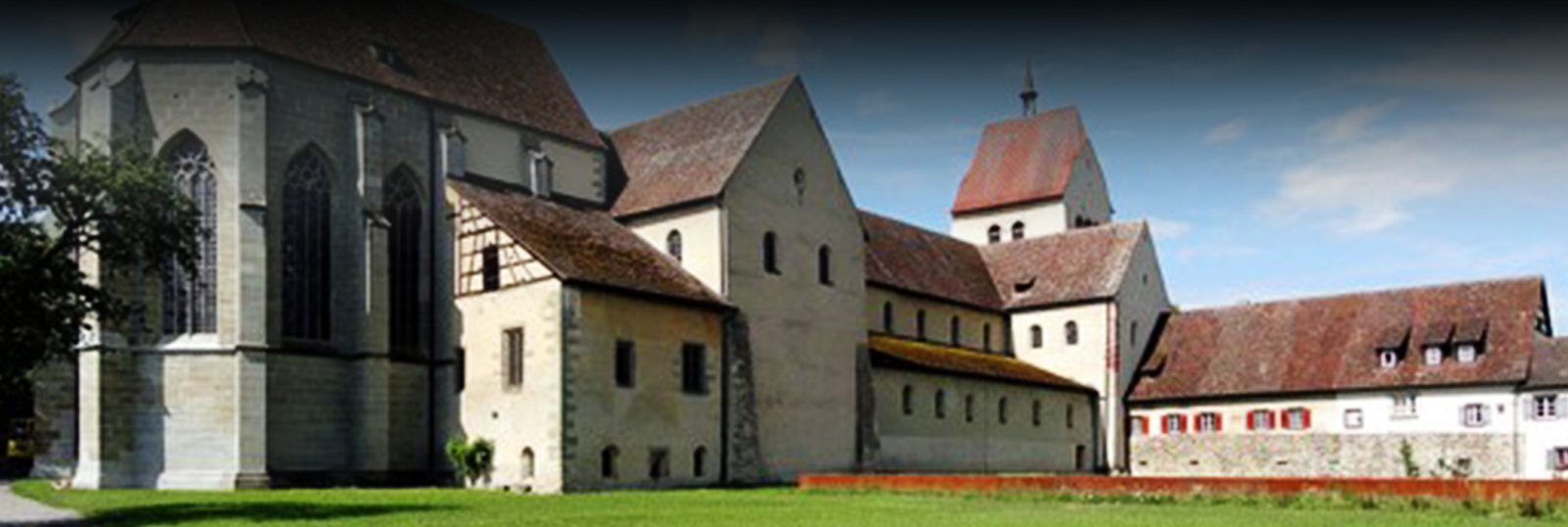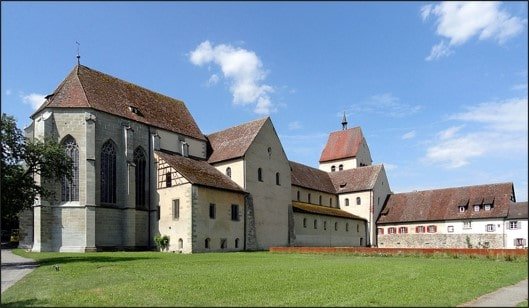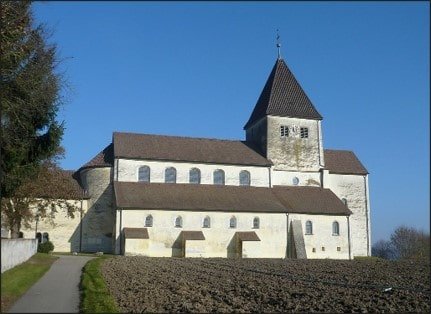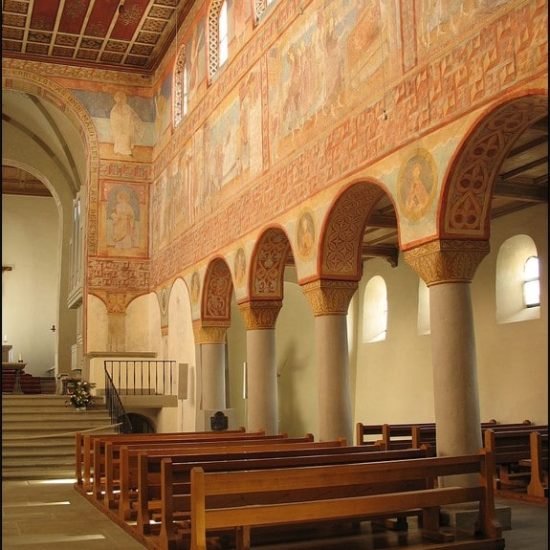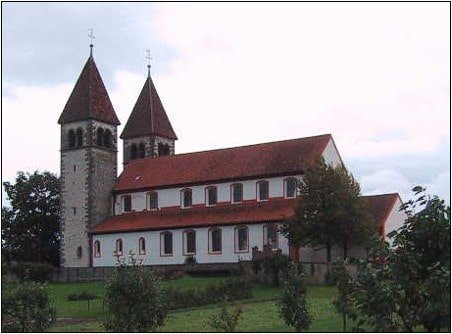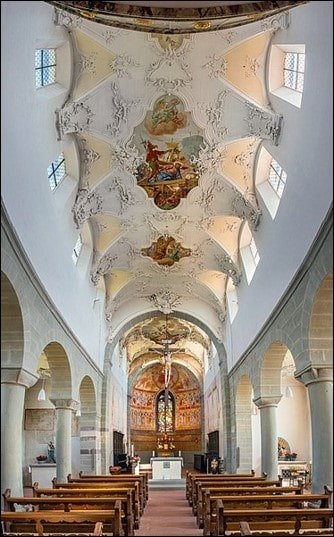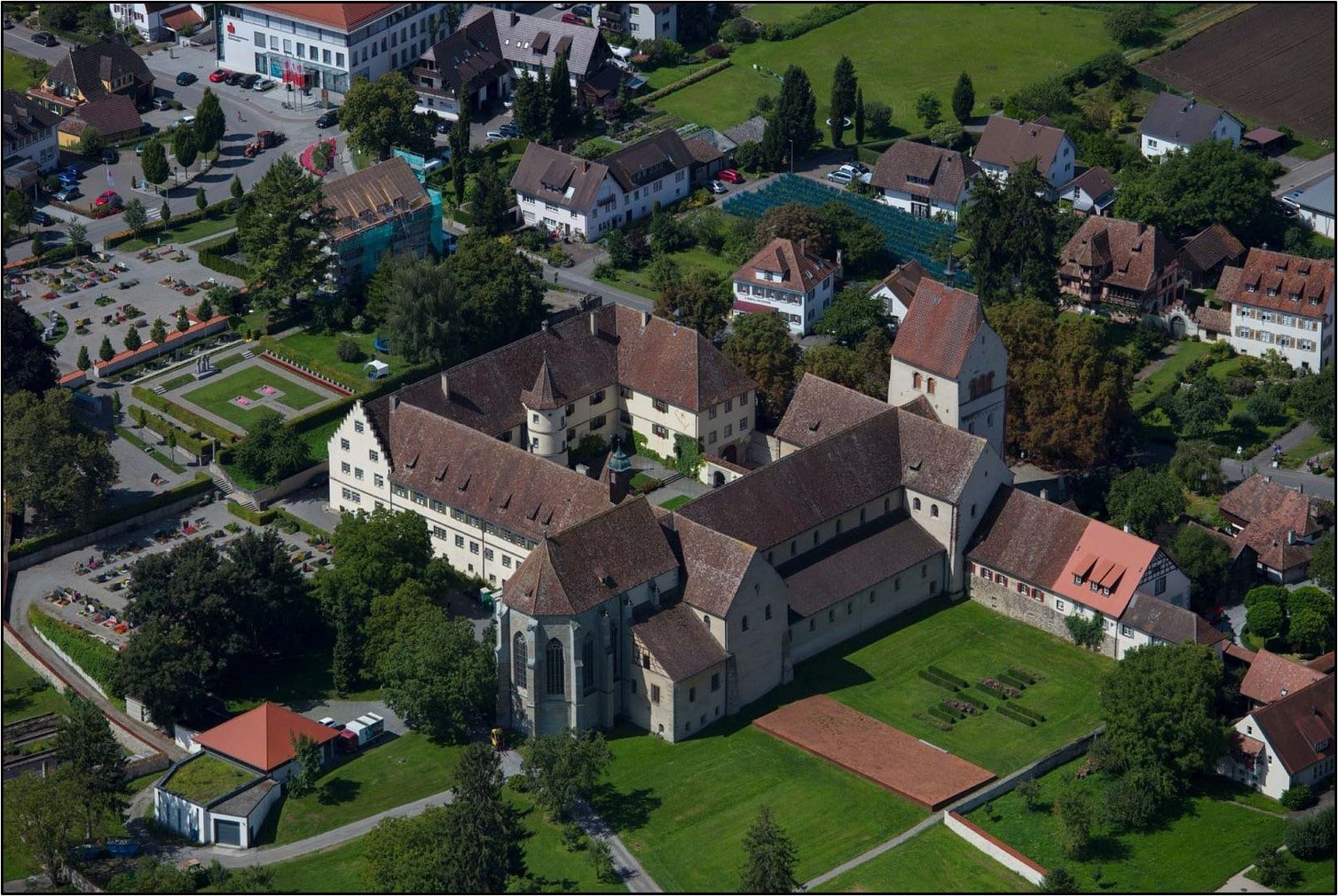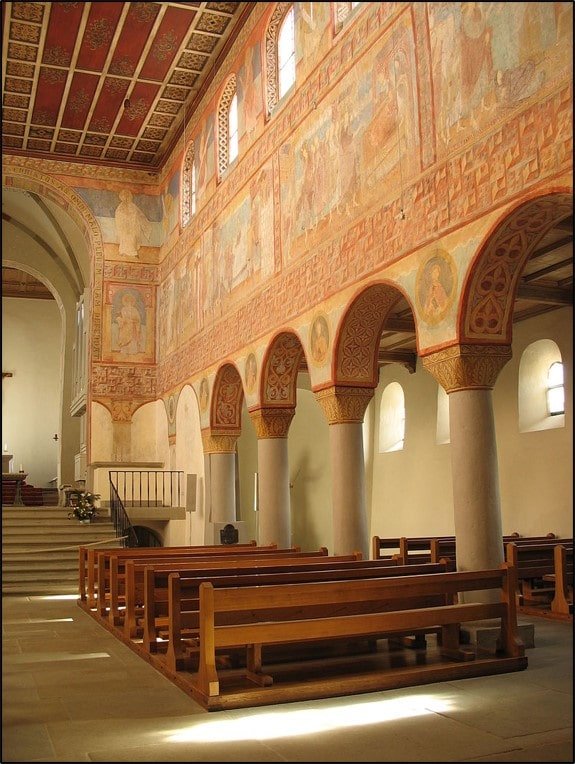Benedicte Abbey of Reicheneau
per person
The Romanesque church towers of Reichenau Monastery on the island of the same name on the Bodensse in the far south of Germany can already be seen from the shore. The monastery has been inhabited by monks – with interruptions – for around 1300 years and is considered one of the most important monasteries during the Carolingian dynasty.
The abbey is particularly famous for its medieval book illumination during the Ottonian period, the artworks were declared to a UNESCO World Documentary Heritage in 2003. Even today, the connection with Reichenau Abbey can be felt in every corner of the island. For example, old monastic festivals are celebrated, church services are held in the four former monastery churches and artifacts from bygone eras of monastic history can still be admired in museums. Since 2001, Benedictine monks have once again inhabited the Cella St. Benedikt, which was established as an officially dependent house of the Archabbey of Beuron in 2004.
FORMAL ANALYSIS
According to the legend of the monastery’s foundation, Saint Pirminius came to Reichenau in 724 with 40 monks to build a chapel on the remote island at the request of the Alemannic Great Sintlas. At that time, the island was still surrounded by the largely pagan Alemanni, which ensured that the Carolingians saw the abbey as an important missionary location. This earned the abbey the favour of the Carolingian rulers in the 8th century and a first period of prosperity. Even Charlemagne visited the monastery in 780 with his wife Hildegard.
As time went on, the monastery grew and several monastic cells were formed on the island. In this way, the Cellae St. Peter and Paul were built at the end of the 8th century and the large Marienmünster at the beginning of the 9th century. In 888, Emperor Charles the Fat was buried here. During this time, the Reichenau Fraternity Book and the world-famous plan of the monastery of St. Gall were drawn up in the scriptoria of Reichenau. At the end of the 9th century, the abbot and Archbishop of Mainz Hatto III also built St. George’s Church, which can still be seen today on the southeast side of the island.
Through the favour of the Ottonian rulers, who granted the monastery far-reaching privileges, the abbey experienced a second period of prosperity in the 10th century. For example, the famous Reichenau writing school was founded, which brought forth important historiographers such as Hermann or Berthold of Reichenau. In addition, the murals in St. George’s Church, which can still be admired today, were painted during this period.
In the following centuries, the spiritual and material decline of the Benedictine abbey finally began. The monastery was no longer able to cope with the social and economic transformations of the High and Late Middle Ages, and so it happened that during the 14th century the entire monastery property was temporarily mortgaged. A few decades later, the monastery, which had only been open to the higher nobility, was also made accessible to the lower nobility.
In the late Middle Ages, the Minster Church was once again extended with a late Gothic choir. In 1540, the abbey finally came to the Bishop of Constance after the abbot Markus von Knöringen renounced his office as prior and Emperor Charles V had signed the monastery over to him as an imperial fiefdom.
After the abbey finally stood up for its independence once again in the 18th century and redesigned the church of St Peter and St Paul in the rococo style, the monks were violently banished from the island in 1757. The monastery was finally dissolved completely in 1803 as a result of the Reichsdeputationshauptschluss and Napoleon’s enforcement of the principle of secularisation.
In the 19th century, the former monastery buildings were finally extensively restored and made accessible to the railway with the construction of a railway embankment across Lake Constance. The former abbey buildings were largely untouched by major destruction in the course of the Second World War, have been extensively refurbished and can therefore still be seen to a large extent in their historical form today.
In 2000, the monastery island of Reichenau was finally included in the UNESCO World Heritage List. From 2001, Benedictine monks once again settled on the island in the Cella St. Benedikt.
The buildings of the former monastery cells are scattered far and wide on Reichenau Island. Today’s parish church of St. Peter and Paul is in the village of Niederzell, the former monastery church of St. Mary and St. Mark is also located as a parish church in Elber, and the church of St. George is in the south-east of the island near Oberzell. Today’s Benedictine convent is housed in the parish house in Niederzell.
All three former monastery churches can be visited today on guided tours. In addition, the former monastery treasure can be viewed in the Minster Church of St Mary and St Mark. In the REICHENAU MUSEUM, visitors can still get a picture of medieval monastic life and learn about the eventful history of the Benedictine abbey. In addition, services of the Catholic parish of Reichenau are still held in all three churches today.
FLORIAN HARTMANN
- BENEDICTINE ABBEY REICHENEAU© PHOT. Hilarmont (Kempten), CC BY-SA 3.0 DE, https://creativecommons.org/licenses/by-sa/3.0/de/deed.en, via Wikimedia Commons, https://de.wikipedia.org/wiki/Kloster_Reichenau#/media/Datei:Kloster_Reichenau_(Foto_Hilarmont).jpg
- THE OLD REICHENEAU ABBEY CHURCH AND TODAY’S ST. MARY AND ST. MARY AND ST. MARK’S PARISCH CHURCH FROM ABOVE© PHOT. Achim Mende, https://www.reichenau- tourismus.de/de/planen-buchen/fuehrungen-fuer-gruppen/rundgaenge-spaziergaenge/ 5-museum-und-muenster
- THE INTERIOR OF THE FORMER ABBEY CHURCH OF ST. MARY AND ST. MARK LOOKING TOWARDS ST. MARK’S ALTAR© PHOT. Klosterkirche_Reichenau_20090821_011.jpg: Wamitoderivative work: Rabanus Flavus, Public domain, via Wikimedia Commons, https://commons.wikimedia.org/ wiki/File:Reichenau_St._ Maria_und_Markus_Inneres_nach_Westen.jpg
- ST. GEORGE’S CHURCH WITH ITS FRESCOES FROM THE TIME OF THE OTTONIANS IN OBERZELL© PHOT. AHBquality, CC BY-SA 3.0, https://creativecommons.org/licenses/by-sa/3.0, via Wikimedia Commons
- ST. GEORGE’S CHURCH WITH ITS FRESCOES FROM THE TIME OF THE OTTONIANS IN OBERZELL© PHOT. AHBquality, CC BY-SA 3.0, https://commons.wikimedia.org/wiki/File:Oberzell_Georgskirche_01.jpg
- THE FORMER MONK’S CELL MONASTERY CHURCH IN NIEDERZELL ST. PETER AND PAUL WITH ITS 18TH CENTURY ROCOCO STYLE INTERIOR© PHOT. Peter Berger, https://commons.wikimedia.org/wiki/File:Niederzell.jpg
- THE FORMER MONK’S CELL MONASTERY CHURCH IN NIEDERZELL ST. PETER AND PAUL WITH ITS 18TH CENTURY ROCOCO STYLE INTERIOR© PHOT. Böhringer Friedirch, CC BY-SA 3.0 AT, https://creativecommons.org/licenses/by-sa/3.0/at/deed.en, via Wikimedia Commons, https://commons.wikimedia.org/wiki/File:Interior_of_St._Peter_und_Paul,_Reichenau_1.jpg
Tour Location
Benedicte Abbey of Reicheneau
| Other monuments and places to visit | The REICHENAU Museum, housed in one of the oldest half-timbered houses in southern Germany, informs visitors about the history of the island and monastic life in the Middle Ages (€5 entrance fee, open from Wednesday to Monday from 10:30 am to 4:30 pm) Strabo's herb garden at the old abbey church of St. Mary and St. Mark, laid out in the 1990s on the historical model of Abbot Walahfrid Strabo's garden from the 9th century. Viewpoint Hochwart, from which you have a fantastic panoramic view of the whole island. The old Schopflen castle ruins with observation platform, which the Abbot of Reichenau had built in the 13th century to protect the island from enemies. Nature reserve “Wollmatinger Ried”, which can be explored with nature guides. |
| Natural Heritage | Lake Constance landscape |
| Historical Recreations | The churches and abbey buildings were restored again and again in the course of time. |
| Festivals of Tourist Interest | St Mark's Festival on 25 April, on which processions with the relic of St. Mark take place across the island. Feast of the Holy Blood on the Monday after Trinity Sunday, on which processions with the relic of the Holy Blood take place across the island. Assumption of the Virgin Mary and Reichenau World Heritage Day on 15 August, where the patrocinium of the Reichenau Minster is celebrated. Reichenau Wine and Fishing Festival (August) |
| Fairs | |
| Tourist Office | Yes, you can find the tourist office of Reichenau Island at Pirminstraße 145 in 78479 Reichenau. |
| Specialized Guides | Yes, you can book individual tours or tours for groups with different thematic focuses here reichenau-tourismus.de by phone +49 7534 92 070 after consultation with the tourist office. |
| Guided visits | Yes, see above. |
| Accommodations | Yes, there are hotels, guesthouses, holiday flats, a campsite and camper pitches on the island |
| Restaurants | There are cafés and restaurants in every village on the island |
| Craft | |
| Bibliography | Theo Keller, Monika Spicker-Beck, Hans Ulrich Wepfer, Reichenau – Schöne Insel im Bodensee, Konstanz 1992. |
| Videos | Sightseeing video of Reichenau: Youtube Report on island life on Reichenau by Southwest German Broadcasting service: Youtube |
| Website | reichenau-tourismus.de/ |
| Monument or place to visit | Reichenau Monastic Island, Reichenau |
| Style | St. Mary and St. Mark’s parish Church as the oldest former Abbey Church with original building substance from the 8th century / St. George’s parish Church with largely original building substance from the 9th century / St. Peter and St. Paul’s parish Church which was rebuilt in the 11th century on the founding walls of the old St. Peter's Church from the 8th century |
| Type | Romanesque architecture |
| Epoch | 8th century / 9th century / Extensions (e.g. the Gothic choir in St. Mary's and St. Mark's church) in the early modern period |
| State of conservation | largely original building substance in the churches from the early middle ages / the old monastery buildings are mostly no longer preserved (with the exception of the former abbey church of St. Mary and St. Mark) |
| Mailing address | For the former Abbey Church St. Mary and Mark: Münsterplatz 4, 78479 Reichenau St. George’s parish Church: Seestraße 4, 78479 Reichenau St. Peter and St. Paul’s parish Church: Eginostraße 12, 78479 Reichenau |
| Coordinates GPS | 47°41′56″ N 9°03′41″ E |
| Property, dependency | Parish community Reichenau / Offers and guided tours by the tourist information of Reichenau / Restorations or publications are financed by the " Welterbe - Klosterinsel Reichenau" foundation |
| Possibility of visits by the general public or only specialists | Yes, everyone can visit all three of today's parish churches. |
| Conservation needs | Yes |
| Visiting hours and conditions | Yes, everyone can visit all three of today's parish churches. |
| Ticket amount | The admission to the churches are free of charge / Admission to the treasury is €2 (closed for renovation in 2023) |
| Research work in progress | Large excavations or research projects are not currently being realised. |
| Accessibility | Good |
| Signaling if it is registered on the route | |
| Bibliography | Wolfgang Erdmann, Die Reichenau im Bodensee. Geschichte und Kunst (= Die Blauen Bücher), Königstein i. Ts. 2004. Thomas Kreutzer, Verblichener Glanz. Adel und Reform in der Abtei Reichenau im Spätmittelalter (= Veröffentlichungen der Kommission für Geschichtliche Landeskunde in Baden-Württemberg. Reihe B: Forschungen 168), Stuttgart 2008. Alfons Zettler, Die frühen Klosterbauten der Reichenau. Ausgrabungen – Schriftquellen – St. Galler Klosterplan (= Archäologie und Geschichte 3), Sigmaringen 1988. Arno Borst, Mönche am Bodensee. 610–1525 (= Bodensee-Bibliothek 5), Sigmaringen 1978. |
| Videos | Film series on the monastery island of Reichenau by the Reichenau Tourist Information: https://www.reichenau-tourismus.de Documentary about the monastery island by Südwestdeutscher Rundfunk broadcasting service: https://www.swrfernsehen.de |
| Information websites | reichenau-tourismus.de wikipedia.org reichenau.de |
| Location | Community of Reichenau in the county of Konstanz in the federal state of Baden Wurttemberg |


